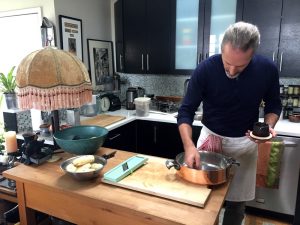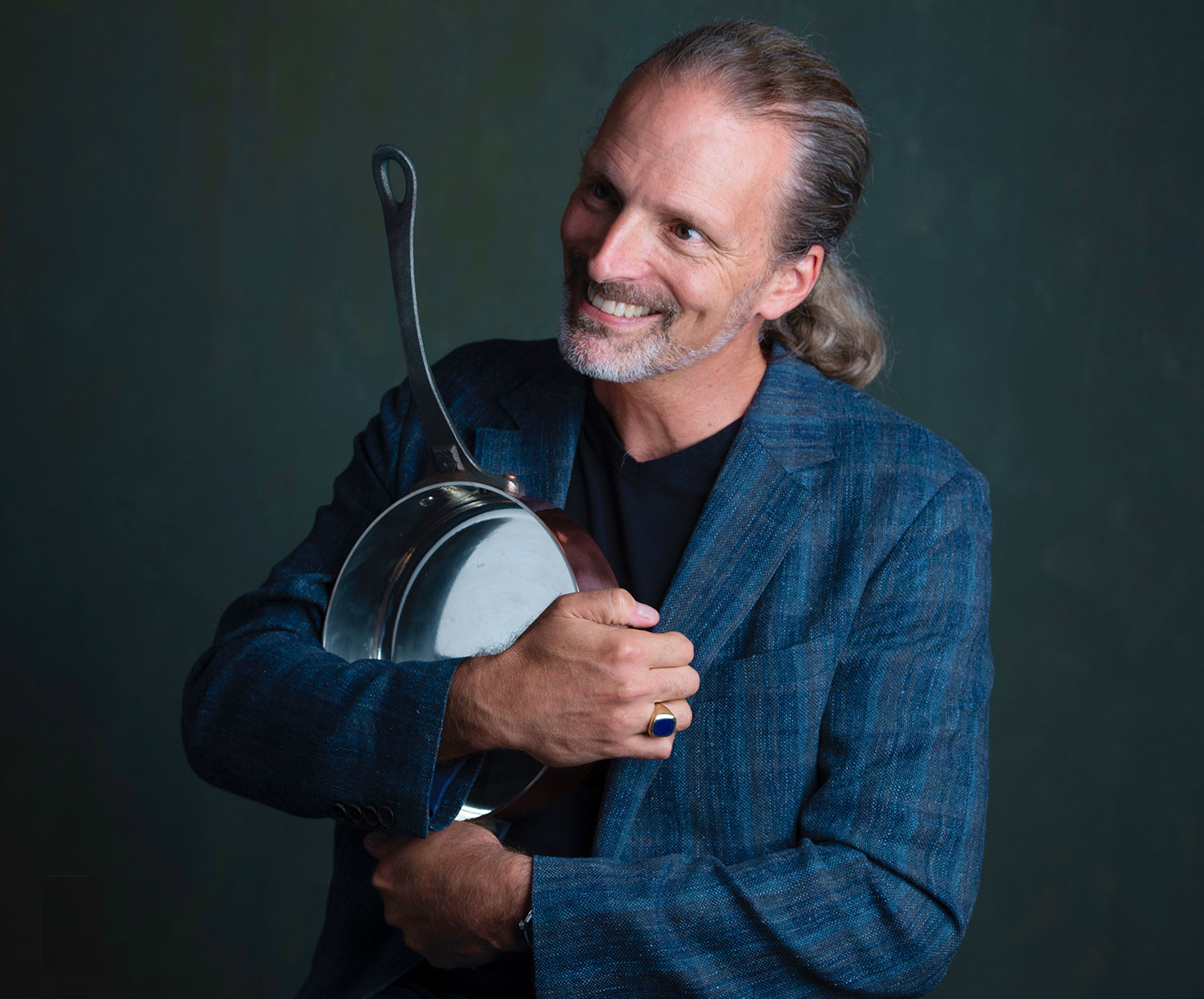
16 Dec The BCC Approach
 In 2009, just about at the bottom of The Great Recession, Brooklyn Copper Cookware got started. When I realized the cookware I loved using most was no longer made in the US, a challenge emerged – clear, simple, and daunting. Produce the finest cooking tools ever made, by hand, entirely in the US.
In 2009, just about at the bottom of The Great Recession, Brooklyn Copper Cookware got started. When I realized the cookware I loved using most was no longer made in the US, a challenge emerged – clear, simple, and daunting. Produce the finest cooking tools ever made, by hand, entirely in the US.
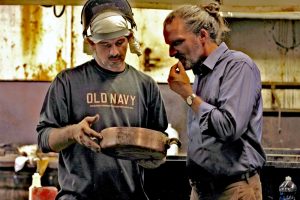 What was the challenge then is the creed now.
What was the challenge then is the creed now.
Copper cookware has been produced more or less the same way for many centuries. There’s not a lot to improve on what has worked so well for so many years, but we determined to figure out a robustly American riff on the pots and pans nearly all accomplished cooks aspire to own at some point.
It took several years of research, sketching, modeling, storms (brain, economic and meteorological), cooking, and a few near-death experiences to arrive at not only deeply satisfying designs, but the means to produce our designs on these shores, one at a time.
Every piece of Brooklyn Copper Cookware expresses exactly what we intended.

Design
The form of, say, a sauté pan follows its function – to “sauter” or jump, small cuts of food around in fat on a hot surface, evaporating liquids quickly. To these culinary ends, the sauté pan has a standard, “classic” proportion. There is, in other words, not much to redesign about the dimensional form of a sauté pan, so we thought about what had perhaps not been envisioned in the long history of copper cookware, starting with the handles.
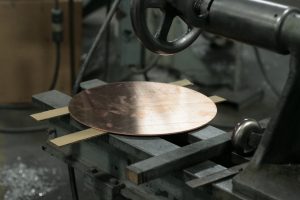
A 1/8″ “Penny” ready for the lathe.
With the help of renowned Brooklyn iron designer Barbara Stork, we spent two years hand-drafting, carving and tooling completely original iron fittings for our batterie de cuisine. Barbara worked with the thermal properties of iron so our handles would sink and radiate energy off before tapering elegantly to keep the grip end cooler longer, adding a spine and palm heel cup for stability and comfort. The result is a masterstroke of form and function.
As our handle designs came together we were teasing out other elements of what would make a great piece of copper cookware the best. The clues were not hard to find:
“Copper pots are the most satisfactory of all to cook in, as they hold and spread the heat well and their tin lining does not discolor food….. To get the full benefit of cooking in copper, the metal must be 1/8 inch thick, and the handle should be of heavy iron.”
Julia Child, Mastering the Art of French Cooking, 1961
 By 2009 no one was making a satisfactory pot, at least not on Julia’s criterion, so we (naively) determined that’s how we’d roll – literally roll our copper sheet to ⅛”, or a little over 3mm thickness, to be spun on our own tools in the classic forms, kitted out with our own, original heavy iron, not only more burly than other copper cookware, but with a few important twists hidden in the materials.
By 2009 no one was making a satisfactory pot, at least not on Julia’s criterion, so we (naively) determined that’s how we’d roll – literally roll our copper sheet to ⅛”, or a little over 3mm thickness, to be spun on our own tools in the classic forms, kitted out with our own, original heavy iron, not only more burly than other copper cookware, but with a few important twists hidden in the materials.
Materials
Pure metal copper cookware contains three ingredients: copper, tin and iron. All elements in the Periodic Table. Nothing really to play with there either. Or was there?
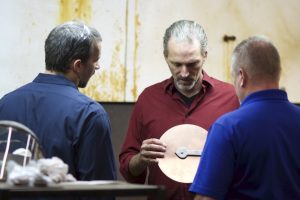 After experimenting for months with hand- tinning our first formulation of pure ROhS-compliant copper (“C11000 Electrolytic Tough-pitch”), we stumbled upon a method for using phosphorus to displace oxygen on the surface of the copper. At the molecular level, oxygen gets in the way of pure tin and copper forming a fine, continuous “intermetallic” ceramic-like compound between the body and lining of a copper pot. Displace the oxygen and tin and copper come together like lovers. As far as we know Brooklyn Copper Cookware pioneered this formulation for use in copper cookware (which we promptly shared with other small makers!).
After experimenting for months with hand- tinning our first formulation of pure ROhS-compliant copper (“C11000 Electrolytic Tough-pitch”), we stumbled upon a method for using phosphorus to displace oxygen on the surface of the copper. At the molecular level, oxygen gets in the way of pure tin and copper forming a fine, continuous “intermetallic” ceramic-like compound between the body and lining of a copper pot. Displace the oxygen and tin and copper come together like lovers. As far as we know Brooklyn Copper Cookware pioneered this formulation for use in copper cookware (which we promptly shared with other small makers!).
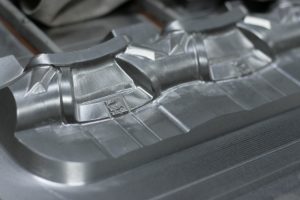 Copper and tin expand and contract together very well through temperature changes, but iron is a much more thermally resistant metal (which, as a handle, helps it stay cool). Over time, this “coefficient of expansion differential” can lead to stress and fatiguing of rivets, or cracking of a normal gray iron handle. The solution was to specify ductile iron for BCC, and we found one of the rare small forges remaining in the US that would not only pour short runs for us, but had sufficient finesse to allow the Brooklyn Copper logo to be incorporated right into the casting. Every handle is milled very precisely to achieve BCC’s exceptionally tight handle joints, so iron and copper can move in sympathy for pretty much ever.
Copper and tin expand and contract together very well through temperature changes, but iron is a much more thermally resistant metal (which, as a handle, helps it stay cool). Over time, this “coefficient of expansion differential” can lead to stress and fatiguing of rivets, or cracking of a normal gray iron handle. The solution was to specify ductile iron for BCC, and we found one of the rare small forges remaining in the US that would not only pour short runs for us, but had sufficient finesse to allow the Brooklyn Copper logo to be incorporated right into the casting. Every handle is milled very precisely to achieve BCC’s exceptionally tight handle joints, so iron and copper can move in sympathy for pretty much ever.
Each of our raw materials cost a bit extra to have milled, poured or purified to our specifications, but each one allows us to make every piece of BCC with absolute minimal waste and the strongest possible marriage of metals. Bonus: What little waste we do generate is 100% recyclable – we just melt it down and mill or cast it again. Our designs assume centuries of use and complete renewability, a promise only pure tin, copper and iron in optimal relationship can make.
Making
When the goal is to make the finest cookware, bar none, how it’s made counts in a big way.
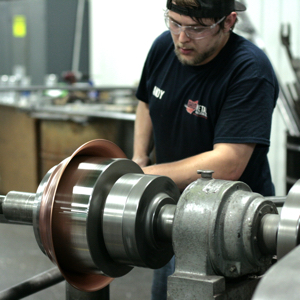 Since BCC makes hand tools for people to use in preparing their sustenance, we knew early on that, as much as it made sense to do so safely, all BCC would be made by hand. From the ironsmiths who pour, trim and grind our handle castings, to the coppersmiths “flopping” 3mm copper sheet on our lathe mandrels, to our rivet maker cold-forging our weird sizes, to our tinsmiths wiping in molten tin, each piece of BCC goes, without hyperbole, from our hands to yours.
Since BCC makes hand tools for people to use in preparing their sustenance, we knew early on that, as much as it made sense to do so safely, all BCC would be made by hand. From the ironsmiths who pour, trim and grind our handle castings, to the coppersmiths “flopping” 3mm copper sheet on our lathe mandrels, to our rivet maker cold-forging our weird sizes, to our tinsmiths wiping in molten tin, each piece of BCC goes, without hyperbole, from our hands to yours.
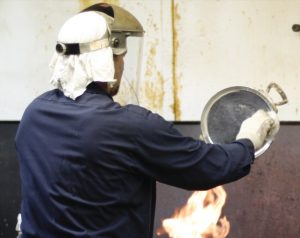 Just as pure copper cookware responds in use like nothing else, so too does it require quick reflexes and thoughtful fabrication in the making. Copper is uniquely advantaged by the maker’s touch, forming, alloying, ringing and shining with the kind of careful attention machines can’t bring to the making of anything, much less tools for sustaining life.
Just as pure copper cookware responds in use like nothing else, so too does it require quick reflexes and thoughtful fabrication in the making. Copper is uniquely advantaged by the maker’s touch, forming, alloying, ringing and shining with the kind of careful attention machines can’t bring to the making of anything, much less tools for sustaining life.
Every single piece of BCC is unique, perfected by its hand-made “imperfections”.
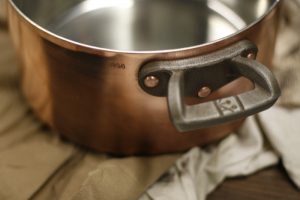
How We Sell BCC
Our copper cookware is a rarity, not only for its robust construction, timeless beauty and infinite renewability (were that not already rare enough), but for the fact that you won’t find it everywhere.
You’ve read how we get up to our elbows in the best materials and centuries-old techniques (and a few clever, invisible improvements) to bring you the finest cookware ever made. Our commitment to making it the way we do limits the number of pieces we will ever make, and so we sell BCC in that most limited of ways – in very small numbers and to you, directly. That way we can keep BCC in range of competitor’s pricing while doing everything to our satisfaction, here in the US, by hand.
The BCC team loves to cook, especially for the folks we love. We have the great good fortune of rising every morning, fixing some breakfast using tools we’ve made, and then heading off to make more of those tools so others can share their talents, their bounty and their love. It’s a pretty great gig.
We look forward to bringing all that and more to your kitchen. To find out more about acquiring BCC, sign up for sales notifications – just over there on the right.
